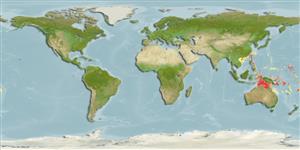>
Perciformes/Scorpaenoidei (Scorpionfishes) >
Triglidae (Searobins) > Triglinae
Etymology: Lepidotrigla: Greek, lepis, lepidos = scale + Greek, trigla, es = red mullet (Ref. 45335).
Eponymy: Dr Barry C Russell is an Australian ichthyologist who was Director of Research and Collections (now Curator Emeritus) at the Museum of the Northern Territory, Darwin (1982–present). [...] (Ref. 128868), visit book page.
Environment: milieu / climate zone / distribuzione batimetrica / distribution range
Ecologia
marino demersale. Tropical
Western Central Pacific: northeast of Goulburn Island, Northern Territory, Australia.
Size / Peso / Age
Maturità: Lm ? range ? - ? cm
Occurs over soft bottom of the continental shelf (Ref. 75154). Type specimen taken from 55 m depth (Ref. 33021). Better reference needed.
Life cycle and mating behavior
Maturità | Riproduzione | Deposizione | Uova | Fecundity | Larve
Eschmeyer, W.N. (ed.), 1999. Catalog of fishes. Updated database version of November 1999. Catalog databases as made available to FishBase in November 1999. (Ref. 33021)
IUCN Red List Status (Ref. 130435: Version 2025-1)
Threat to humans
Harmless
Human uses
Pesca: di nessun interesse
Strumenti
Special reports
Download XML
Fonti Internet
Estimates based on models
Preferred temperature (Fonte Biblio.
123201): 22 - 28.2, mean 26.8 °C (based on 240 cells).
Phylogenetic diversity index (Fonte Biblio.
82804): PD
50 = 0.5000 [Uniqueness, from 0.5 = low to 2.0 = high].
Bayesian length-weight: a=0.01000 (0.00244 - 0.04107), b=3.04 (2.81 - 3.27), in cm total length, based on all LWR estimates for this body shape (Ref.
93245).
Trophic level (Fonte Biblio.
69278): 3.4 ±0.3 se; based on size and trophs of closest relatives
Resilienza (Fonte Biblio.
120179): Alto, tempo minimo di raddoppiamento della popolazione meno di 15 mesi (Preliminary K or Fecundity.).
Fishing Vulnerability (Ref.
59153): Low vulnerability (10 of 100).
🛈
